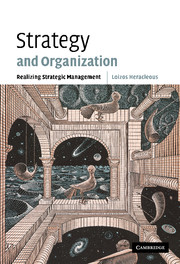Book contents
- Frontmatter
- Contents
- List of figures
- List of tables
- Preface
- I Bases of strategic management
- II Realizing strategy
- 5 The complexities of strategy implementation
- 6 Organizational culture and strategic change processes
- 7 The role of organizational discourse in understanding and managing strategic change
- 8 Strategic change processes: an organization development approach
- III Current themes and applications
- Index of names
- Index of subjects
- References
8 - Strategic change processes: an organization development approach
Published online by Cambridge University Press: 11 May 2010
- Frontmatter
- Contents
- List of figures
- List of tables
- Preface
- I Bases of strategic management
- II Realizing strategy
- 5 The complexities of strategy implementation
- 6 Organizational culture and strategic change processes
- 7 The role of organizational discourse in understanding and managing strategic change
- 8 Strategic change processes: an organization development approach
- III Current themes and applications
- Index of names
- Index of subjects
- References
Summary
This chapter describes an organization development (OD) approach to managing strategic change processes, based on an “integrated organizational model” developed for this purpose, and illustrates its use through an empirical example. The process of applying the model and learning from this and other OD interventions shows how closer integration between the fields of OD and strategic management can help to bridge the gap of relevance between academic and practitioner concerns. The findings also highlight useful lessons which merit careful consideration by top management teams when developing strategy, and planning and leading strategic change. In terms of the organizational action (OA) view, this chapter exemplifies a processual approach to strategic choice and implementation that takes into account key organizational factors in planning for and implementing change. In addition, it presents an OD-oriented decision process that can support strategic choices by the dominant coalition; in doing so, it emphasizes the value of integrating OD with strategic management, in terms of enhanced practitioner relevance and more effective strategy implementation.
The need for relevance of the strategic management field
Strategic management is an applied field and as such its survival and growth depends not only on its theoretical sophistication and methodological rigor, but also on its relevance to practitioners Bower (1982; Seth and Zinkhan 1991). In spite of that, practitioners often do not perceive such relevance Bennett (1988; Business Week 1990).
- Type
- Chapter
- Information
- Strategy and OrganizationRealizing Strategic Management, pp. 125 - 146Publisher: Cambridge University PressPrint publication year: 2003



